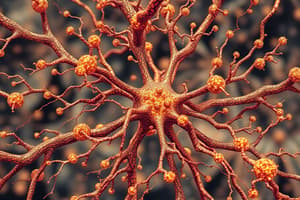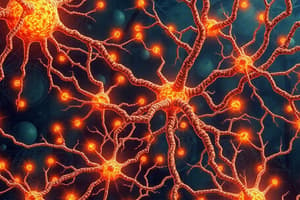Podcast
Questions and Answers
Which neurotransmitter primarily functions to stabilize the brain by decreasing neural transmission, thus preventing over-excitation?
Which neurotransmitter primarily functions to stabilize the brain by decreasing neural transmission, thus preventing over-excitation?
- GABA (correct)
- Norepinephrine
- Serotonin
- Dopamine
A medication targets which neurotransmitter to enhance wakefulness and alertness?
A medication targets which neurotransmitter to enhance wakefulness and alertness?
- Norepinephrine (correct)
- Dopamine
- Serotonin
- GABA
In neuronal communication, what role do neurotransmitters serve?
In neuronal communication, what role do neurotransmitters serve?
- Carrying signals across the synapse (correct)
- Insulating the axon
- Providing energy to the cell body
- Structural support of the neuron
Which part of a neuron is responsible for receiving messages from other neurons through receptors?
Which part of a neuron is responsible for receiving messages from other neurons through receptors?
Medications delivered via deep tissue injection are administered through which route?
Medications delivered via deep tissue injection are administered through which route?
Compared to oral administration, what is a key consideration when choosing transdermal drug delivery?
Compared to oral administration, what is a key consideration when choosing transdermal drug delivery?
What does a small therapeutic index of a drug indicate?
What does a small therapeutic index of a drug indicate?
After drug adminitration, what is the correct order of the four stages of pharmacokinetics?
After drug adminitration, what is the correct order of the four stages of pharmacokinetics?
Which organ is primarily responsible for metabolizing drugs into active metabolites?
Which organ is primarily responsible for metabolizing drugs into active metabolites?
Which class of medication is typically the first choice for treating psychotic behaviors?
Which class of medication is typically the first choice for treating psychotic behaviors?
Alcohol and benzodiazepines act as agonists on which neurotransmitter?
Alcohol and benzodiazepines act as agonists on which neurotransmitter?
Medications used to treat psychosis primarily target which neurotransmitter system?
Medications used to treat psychosis primarily target which neurotransmitter system?
How do beta-blockers alleviate anxiety symptoms?
How do beta-blockers alleviate anxiety symptoms?
What is the key difference between SSRIs and SNRIs in terms of their target neurotransmitters?
What is the key difference between SSRIs and SNRIs in terms of their target neurotransmitters?
Why do many antidepressant medications commonly cause gastrointestinal side effects?
Why do many antidepressant medications commonly cause gastrointestinal side effects?
Why is dehydration a concern for individuals taking lithium?
Why is dehydration a concern for individuals taking lithium?
Why are TCAs (tricyclic antidepressants) considered 'not clean' medications?
Why are TCAs (tricyclic antidepressants) considered 'not clean' medications?
What distinguishes bioequivalence from bioavailability?
What distinguishes bioequivalence from bioavailability?
Medications exhibit different timelines for the onset of withdrawal symptoms due to differences in what pharmacokinetic parameter?
Medications exhibit different timelines for the onset of withdrawal symptoms due to differences in what pharmacokinetic parameter?
What is the general underlying principle that explains why exogenous stressors worsen or 'trigger' bipolar disorder?
What is the general underlying principle that explains why exogenous stressors worsen or 'trigger' bipolar disorder?
Flashcards
GABA
GABA
Inhibitory neurotransmitter that stabilizes the brain by decreasing neural transmission, preventing over-excitation.
Norepinephrine
Norepinephrine
Excitatory neurotransmitter involved in wakefulness and alertness.
Neurotransmitters
Neurotransmitters
Chemical messengers that transmit signals across the synapse between neurons.
Soma
Soma
Signup and view all the flashcards
Dendrites
Dendrites
Signup and view all the flashcards
Axon
Axon
Signup and view all the flashcards
Terminal Buttons
Terminal Buttons
Signup and view all the flashcards
Pharmacokinetics
Pharmacokinetics
Signup and view all the flashcards
Pharmacodynamics
Pharmacodynamics
Signup and view all the flashcards
Common Routes - Drug Admin
Common Routes - Drug Admin
Signup and view all the flashcards
Small Therapeutic Index
Small Therapeutic Index
Signup and view all the flashcards
4 Stages of Pharmacokinetics
4 Stages of Pharmacokinetics
Signup and view all the flashcards
Liver
Liver
Signup and view all the flashcards
Atypical Antipsychotics
Atypical Antipsychotics
Signup and view all the flashcards
GABA
GABA
Signup and view all the flashcards
Dopamine
Dopamine
Signup and view all the flashcards
Beta-blockers
Beta-blockers
Signup and view all the flashcards
SSRIs vs SNRIs
SSRIs vs SNRIs
Signup and view all the flashcards
GI Side Effects - Antidepressants
GI Side Effects - Antidepressants
Signup and view all the flashcards
Lithium Metabolism
Lithium Metabolism
Signup and view all the flashcards
Study Notes
- Neurotransmitters are chemical messengers carrying signals across synapses.
- GABA is an inhibitory neurotransmitter that stabilizes the brain by decreasing neural transmission, preventing over-excitation.
- Norepinephrine is an excitatory neurotransmitter involved in wakefulness and alertness.
- A neuron consists of four basic parts: soma, dendrites, axon, and terminal buttons.
- The soma, or cell body, contains the nucleus, mitochondria, and cytoplasm, all enclosed by a membrane.
- Dendrites are neuron branches that receive messages from other neurons via molecular receptors.
- The axon is a slender tube carrying messages from the soma to terminal buttons.
- Terminal buttons contain vesicles holding neurotransmitters, which are delivered across a synapse to other neurons.
- Common drug administration routes: orally, subcutaneously, intramuscularly, intradermally, intranasally, inhalational, sublingually, transdermally, and intravenously.
- Transdermal administration differs from oral in how fast it acts and in patient compliance.
- A small therapeutic index indicates a less safe drug, often requiring blood level monitoring.
- Pharmacokinetics involves four stages after administration: absorption, distribution, metabolism, and elimination.
- The liver is the primary organ responsible for breaking down drugs into active metabolites.
- CYP450 enzymes in the liver are key in drug metabolism.
Anxiety and Psychosis
- Atypical antipsychotics are the recommended starting point for treating psychotic behaviors.
- Alcohol and benzodiazepines act as agonists to the GABA neurotransmitter.
- Dopamine is the primary neurotransmitter target for medications that treat psychosis.
- Beta-blockers, used for anxiety, are antagonists that block activating neurotransmitters like norepinephrine and adrenaline, slowing heart rate.
Depression and Bipolar Disorder
- SSRIs target serotonin, while SNRIs target norepinephrine and serotonin.
- GI side effects are common with antidepressants due to many serotonin receptors being located in the gut.
- Lithium is not metabolized in the liver and is excreted unchanged by the kidneys; dehydration can lead to toxicity due to increased reabsorption.
- TCAs, older antidepressants, affect many different systems and are not considered "clean" medications.
- Medications starting with "B" used to treat anxiety disorders: benzodiazepines, beta-blockers, barbiturates, and buspirone.
- Bioavailability refers to how much of a drug is available for use after pharmacokinetics.
- Bioequivalence measures the comparative efficacy of different drugs.
- Medications have different timelines for withdrawal symptoms due to varying half-lives.
- Bipolar disorder originates endogenously, but exogenous or psychosocial stressors can trigger or worsen cycles.
Antipsychotic EPS Effects, and Panic Disorder stages
- Four common EPS effects of antipsychotics: acute dystonia, parkinsonism, akathisia, and tardive dyskinesia.
- Acute dystonia involves intermittent or sustained muscle spasms of the trunk, head, and neck.
- Parkinsonism includes rigidity, bradykinesia, shuffling gait, and tremor.
- Akathisia presents clinically as feelings of inner restlessness and the inability to sit still.
- Tardive dyskinesia may include abnormal movements like lip smacking, facial grimacing, and tremors.
- Panic disorder treatment stages: stopping panic, regulating the limbic system with drugs that increase serotonin, and providing psychotherapy to reduce anticipatory anxiety.
Studying That Suits You
Use AI to generate personalized quizzes and flashcards to suit your learning preferences.






